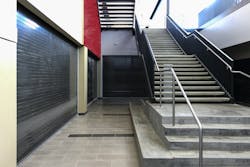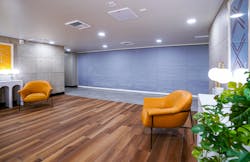A National Fire Protection Association (NFPA) report states that fire doors can reduce the risk of a fire spreading by up to 75%. Fire-rated doors play a critical role in protecting building occupants until help arrives and support the work of emergency response professionals. While fire closures share similar characteristics, they are not all the same and do not always solve the same design challenges.
For example, rolling fire doors and smoke and fire curtains are in different categories and vary in terms of design features, materials, fire-resistance ratings, and operation. Some products do not meet minimum headroom requirements and have alarm-activated closure rather than fire-activated closure. Many lack important features like automatic reset following a fire alarm or drop test.
Design differences directly impact performance. In open spaces, such as atriums and corridors, smoke can spread rapidly, blocking escape routes and exposing occupants to toxic fumes. So, fire and smoke-rated closures must meet specific elevator lobby design requirements in open vestibule settings where standard rolling steel doors may not be appropriate.
Partnering with a manufacturer that embraces design nuances and offers performance-based solutions simplifies fire protective selection. A product like the Cornell SmokeShield® Fabric Smoke and Fire Door, for example, compartmentalizes areas by sealing the curtain within the guide channels. This door is S-labeled and tested to UL 1784 standards, demonstrating that it has passed air leakage tests for preventing the spread of smoke.
Smoke containment is a fundamental feature of the SmokeShield® Elevator Smoke Curtain. The International Building Code requires a lobby for elevators in buildings that are four or more stories. The SmokeShield Elevator automatically seals hoistway openings after each cycle —containing smoke and preventing it from spreading throughout the building — and is a viable alternative to the traditional lobby requirement, leaving architects with more flexibility when designing spaces.
Choosing the right solution to fit a wide range of applications can be challenging. Doors made for fire-rated openings also provide security and access control. Fire-rated doors are used in openings that are not part of a required means of egress, compartmentalizing openings in firewalls, corridors, and mechanical rooms to contain both fire and smoke — which can be equally damaging and dangerous.
It is important to consider style, reliability, and ease of use when selecting a fire-protective door. The protective door’s functionality should align with the building owner's emergency response plan while complementing the architect's or designer’s vision.
A recent installation in an eight-story luxury high-rise in California illustrates how Cornell uses a comprehensive approach to deliver customized solutions. With a diverse product selection, the ability to modify designs to fit building requirements, and in-house manufacturing, Cornell was able to meet distinct architectural and performance requirements.
One of the products installed was the SmokeShield® Elevator Smoke Curtain, which uses patented GuideLock™ technology to reseal the hoistway after each elevator cycle. Unlike other solutions that would detract from the aesthetics of the luxury high-rise, the elevator smoke curtains attractively seal off hoistway openings and limit dangerous smoke infiltration throughout the structure with some of the smallest headroom, backroom, and side room requirements. This elevator smoke curtain is tailored to multistory buildings and is particularly valuable in the fire protection planning process because it can eliminate the IBC Elevator lobby requirement.
The contractor also needed a way to seal off a large mezzanine area in the event of a fire and wanted to use the SmokeShield® Fabric Smoke and Fire curtain, but there were two obstacles to installing it: scheduling and size. Taking on the challenge, engineers designed and custom-crafted a 30-foot-wide curtain specifically for the building — the largest of its kind in the country — and delivered it in time to be installed on schedule. In addition to meeting the performance requirements, the smoke and fire curtain is designed for the guides to be directly installed in masonry or drywall construction, and the headbox can be installed flush into the soffit with the guides hidden underneath the fascia.
A third solution was used in the parking area, which required closures that could withstand a high volume of traffic. This necessitated a design without a lot of components like springs, rollers, and straps. The answer was two Extreme Series 1024 million cycle service doors with a springless design. The doors operate up to 24 inches per second, delivering performance at a lower cost per cycle than other high-performance, slatted products.
Cornell streamlines installation by optimizing products for assembly during manufacturing. For instance, some fire-rated doors are shipped with pre-assembled components, adjustable brackets, guides with clear attachment points, simple release mechanisms, and step-by-step instructions.
As architectural requirements evolve and international codes and standards change, fire-rated commercial door designs need to keep pace. Cornell has consistently set the bar for innovation, making ongoing investments in advanced engineering technology, exceptional manufacturing, and unique installation methods. Cornell continues to push the boundaries of operation, dependability, and performance to solve aesthetic and functional challenges in the building industry.
Sponsored By:



